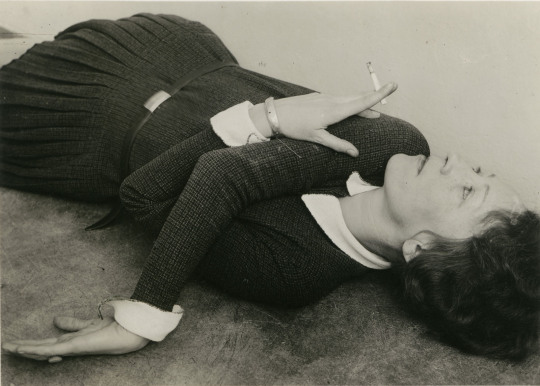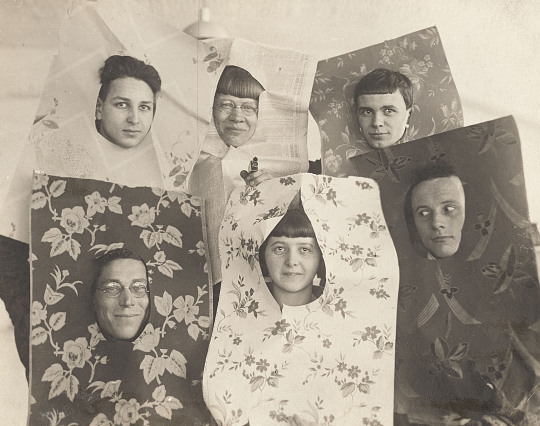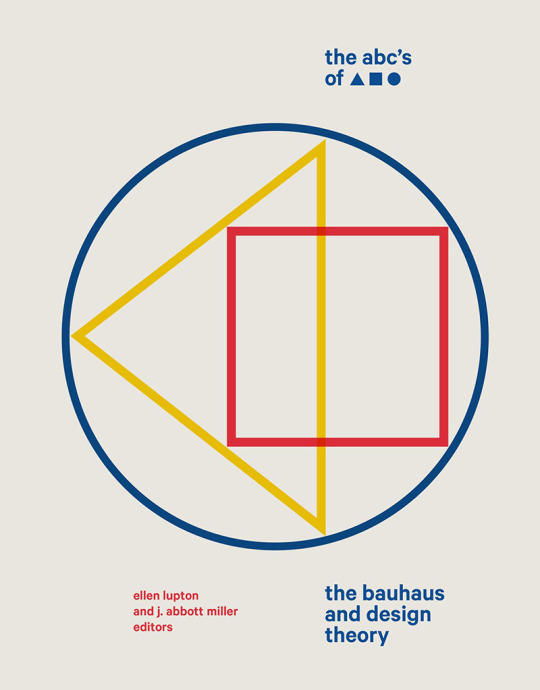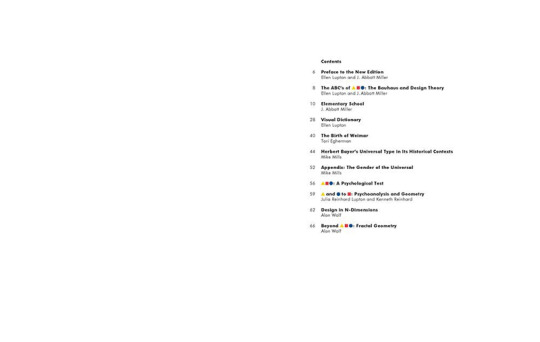#bauhauslers
Text

Grit Kallin-Fischer ~ Selbstporträt mit Zigarette, 1928 (Frauen des Bauhauses in Bildern) | src Frauen am Bauhaus 2019
view more on wordPress
#Bauhaus#Grit Kallin Fischer#bauhaus women#Bauhauslers#women artists#self portrait#Frauen am Bauhaus#Grit Kallin#Grit Kallin-Fischer#1920s#selbsporträt#lying down#portrait#autoportrait#Porträt#retrato#ritratto#portret#retrat#Bildnis#smoking cigarette#Frauen des Bauhauses
320 notes
·
View notes
Photo

@thisiscollins Design is not what we make. Design is what we make possible. But how can we ensure those possibilities create more positive impacts than negative? Few design philosophies answered this question as well as the Bauhaus. They saw design as a bold statement of optimism for the present and the future—infused with creativity, curiosity and purpose. Against the specter of Nazism, the Bauhaus disbanded. But the movement spread. In 1937, Bauhausler László Moholy-Nagy founded the New Bauhaus in Chicago, which became the Institute of Design (ID) at Illinois Tech. Today, ID continues to push the frontiers of design—pioneering ways to solve daunting societal, environmental and business challenges. THE PROBLEM The problem is design. Or rather, its perception. Many prospective ID students and business partners are unaware design can positively shape careers, companies and communities. As ID’s 85th anniversary approached, COLLINS was invited to help evolve ID for the future—and build a new identity around their vision of the transformative power of design. THE SOLUTION At ID, design identifies promising possibilities and refines the best—a dynamic process building towards positive impact. The idea of “The Evolutionary” led us to a new voice and visual language that could itself evolve. Inspired by Moholy-Nagy’s geometric experiments and ID's legendary director Jay Doblin’s genius with complex systems, we crafted six foundational structures able to transform abstract shapes into words and images—moving seamlessly from chaos to clarity, like design itself. The dynamism of this system is ID’s story, showing the world design’s power to create positive possibilities—an idea even more urgent today than in 1937. . . . #Branding #graphicindex #collectgraphics #posterdesign #identity #branddesign #generaleclectics #typography #femmetype #visualdiary #designfeed #visualgraphc #packagingdesign #certainmagazine #creativedirection #printdesign #tdkpeepshow #girotypeface #morulatype #type01 #typography #blkmarket #aigaeyeondesign #certainmagazine #collectgraphics #365typefaces #lavendertype #worldoftype #eyeondesign #fruitsartclub https://www.instagram.com/p/Cj6-RF_Bb-G/?igshid=NGJjMDIxMWI=
#branding#graphicindex#collectgraphics#posterdesign#identity#branddesign#generaleclectics#typography#femmetype#visualdiary#designfeed#visualgraphc#packagingdesign#certainmagazine#creativedirection#printdesign#tdkpeepshow#girotypeface#morulatype#type01#blkmarket#aigaeyeondesign#365typefaces#lavendertype#worldoftype#eyeondesign#fruitsartclub
2 notes
·
View notes
Text
elastic “polymedium.”
With Design in Motion, Laura Frahm proposes an alternate history of the Bauhaus—one in which visual media, and film in particular, are crucial to the Bauhaus's visionary pursuit of integrating art and technology. In the first comprehensive examination in English of film at the Bauhaus, Frahm shows that experimentation with film spanned a range of Bauhaus practices, from textiles and typography to stage and exhibition design. Indeed, Bauhausler deployed film as an adaptable, elastic “polymedium,” malleable in shape and form, unfolding and refracting into multiple material, aesthetic, and philosophical directions.
0 notes
Photo






Bauhäusle
(aka Little Bauhaus)
Self-built accommodation for students by students in Stuttgart.
“The Bauhäusle was based on Walter Segal’s self-build method. Segal, a German-born British architect, believed anyone who could use basic tools could build their own houses. He designed a system using timber, panels and bolts to make the task as easy as possible.”
http://www.bauhaeusle.de/
https://www.theguardian.com/cities/2018/nov/26/a-playground-for-grown-up-kids-inside-the-student-housing-built-by-its-residents-bauhausle-stuttgart
1 note
·
View note
Photo

#bauhauslive (at The Hollywood Palladium) https://www.instagram.com/p/B4bzKQRjgSj/?igshid=15ccvh0rnpdph
0 notes
Text

Bauhausler László Moholy-Nagy taking photos at the De La Warr Pavilion in Bexhill-on-Sea, designed by the architects Erich Mendelsohn and Serge Chermayeff and constructed in 1935. All the other photos of the De La Warr Pavilionare are by Moholy-Nagy and were made in the summer of 1936.
3 notes
·
View notes
Text
100 Years Of Bauhaus
Bauhaus is mostly associated with design and architecture — with pragmatic functionalism, geometric shapes and primary colors that would finally say goodbye to nostalgic ornaments and historical references. The catastrophic experiences of WWI motivated the Bauhauslers to rethink life, society and the everyday world radically. Rejecting traditional knowledge, the Bauhaus forged a school of design in which young people were to develop their artistic creativity. By learning with and from materials, they aimed to give shape to the modern age and meet its many demands. In doing so, the focus was less on the individual work of art than on everyday objects which were to be manufactured in collaboration with industry.
During the 14 years spell of intense, life-changing creativity, the influential design school existed in three German cities; Weimar (1919-1925), Dessau (1925-1932) and lastly in Berlin (1932-1933), and was during the period directed by Walter Gropius, Hannes Meyer, and Ludwig Mies van der Rohe. In 1933 the school was closed by its own leadership under pressure from the Nazi regime, having been painted as a center of communist intellectualism.
The most significant period was when the school was located in East German Dessau from 1925 to 1932. Designed by Walter Gropius, the founder of Bauhaus, the historic building embodies the core principles and values that define the holistic epochal art- and design movement that still echoes in contemporary design today. The building’s objective was to facilitate the creation of a Gesamtkunstwerk — a total work of art — where everything was designed as a whole entity.
The bold and progressive campus features an asymmetric pinwheel plan, with dedicated areas for teaching, an auditorium and offices, and housing for students and faculty distributed throughout three wings connected by bridges. The design does not visually amplify the corners of the building, which creates an impression of transparency. Gropius designed the various sections of the building differently, separating them consistently according to function. He positioned the wings asymmetrically; the form of the complex can thus be grasped only by moving around the building. There is no central view.
The Bauhaus promoted a unified vision for the arts that made no distinction between form and function, as well as an appreciation of the evolving relationship between art and industry. “Bauhaus strives to unite all artistic disciplines — sculpture, painting, crafts and crafts — into a new building art (...) Architects, sculptors, painters, we all have to return to the craft,” Gropius wrote in the manifesto that defined the school. The manifesto attracted not only lots of students from all over the world but also artists such as Paul Klee, Wassily Kandinsky and Johannes Itten, who, as masters, were to shape the students creatively. Gropius wanted to create a new breed of artists, who could turn their hands to anything. Traditional art schools were conservative and elitist. Technical colleges were dreary and conventional. Gropius broke down the barrier between fine art and applied arts.
Both the school’s director and instructors lived in four semi-detacheds “Masters’ Houses” on the campus, designed by Gropius. Part artist colony, part utopian estate, these homes combined work and leisure spaces into a living, breathing manifestation of the Bauhausian dream and became the artists’ colony of the twentieth century.
Students learned pottery, printmaking, book-binding and carpentry. They studied typography and advertising. They went back to basics and began again with fresh eyes. The completed building encapsulated the notion of a Gesamtkunstwerk, with interior fittings, furniture and lighting produced in the school’s workshops. Spartan interior such as Marcel Breuer’s world-famous design classics, the mid-1920s steel pipe furniture, Josef Alber’s geometric shelves-system in wood to Otto Lindig’s significant pottery, Martha Erps graphical weaving techniques, and well-designed accessories like Max Krajewski’s silver-bronze tea-glass with ebony handles becomes a unit of elegance in the building.
The broad, interdisciplinary approach taken by the school’s instructors and their students considered fine arts, graphic design, advertising, architecture, product and furniture design, and theory not as separate fields, but as parts of a conversation about living in the modern world and with ambition towards the betterment of society. Though the Bauhaus set its sights on bringing its ideas into the mainstream, during the complexity of the interwar years, these concepts were still considered avant-garde.
Despite the closure of the school in 1933, the ideas of the Bauhaus spread worldwide. Many of the Bauhaus masters went into exile and became professors at successor institutions. The students who arrived at the Bauhaus Dessau from 29 different countries also disseminated the Bauhaus ideas in their homelands.
Bauhaus cannot be reduced to one single concept. The school changed artistic directions several times that Bauhaus was a school, a workshop, an idea — but never a style. The historic Bauhaus moved between the realms of radical utopia, social vision and reality. Its goal was to develop timely designs for everyday life. These ideas were most consistently and most emblematically actualised and inscribed into the fabric of everyday life with the Bauhaus buildings in Dessau. The Bauhaus astonished and, in some cases, horrified contemporaries.
It was a new way of thinking, and a century since it was born, at the end of WWI, its ideas still set the pattern for the way we live today. Mies van der Rohe’s famous motto, “Less is More”, or the iconic manifestation of Louis Sullivan's “Form follows function” are clear examples of how Bauhaus principles are highly relevant today. Today Bauhaus influences can be seen everywhere from furniture to graphic design. An instigator in the minimalism trend which is still one of the most popular styles to date, Bauhaus helped the design world step away from the ornate designs of the early 20th century with its emphasis on function before form. Other leading styles, like Scandinavian, industrial and mid-century modern, are unmistakable in their Bauhaus influences, showing how far the spread of the school’s teachings have reached.
Once a radical revolt against the status quo, the Bauhaus style has become the new normal. And by becoming ubiquitous, it has disappeared - into the décor of our daily lives.
#Bauhaus#Germany#Walter Gropius#Hannes Meyer#Ludwig#Mies van der Rohe#Design#Architecture#Iconic#Featured
13 notes
·
View notes
Quote
We start to build things, and we design them to get attention - to be bigger, more perfect, and we totally forget that people need to live there. It looks great on the poster, and if you take a picture, but that’s not what architecture is about. It’s about building something for people, to make them feel welcome… somewhere they can be happy.
Annika, Bauhausle resident
BAUHAUSLE (2018)
Short documentary video about this unique student housing, which residents have been allowed to continually edit and adapt. The project was originally constructed by architecture students, as an experiment based on Modernist Walter Segal’s self-build method. Now the tenants are given basic carpentry training and materials to enable them to maintain and personalise their home. (Image via The Guardian, with an interesting article on the project here).
43 notes
·
View notes
Text
At the Bauhaus, Music Was More Than a Hobby
The influential design school never had a proper music department. But musical thinking permeated the lives of its students and faculty.

An image from Oskar Schlemmer’s “Triadic Ballet,” a version of which used a piano-roll score by Hindemith in one of the little-studied collaborations between the Bauhaus and contemporary composers.Credit...ullstein bild, via Getty Images
By Joshua Barone
DESSAU, Germany — A centennial is often an occasion to reconsider history, perhaps with discoveries to be had in neglected corners of the past.
Take the celebrations surrounding the Bauhaus, the short-lived yet immensely influential art and design school founded 100 years ago. Here in Germany, new museums that revisit its legacy are opening in Weimar and Dessau. (A third, an expansion of the Bauhaus Archive in Berlin, is planned for 2022.) Female students and teachers, overlooked for decades, are finally getting their due in books, film and television.
Maybe it’s also time to rethink the Bauhaus’s relationship with music.
Although its mission was to combine all art forms, the school never had a proper music department. But musical thinking permeated the lives of its students and faculty. Some took a synesthetic approach to color and tone, or used the language of symphonies to describe their work; many were amateur instrumentalists who came together in an exuberant, ad hoc band; and some also cultivated relationships with groundbreaking composers, including Schoenberg and Stravinsky.
“Music was central to the hearts and minds of Bauhaus people,” Torsten Blume, a researcher at the Bauhaus in Dessau who specializes in the school’s theater and dance history, said in an interview. They had a passion for music, but not always the knowledge, he added, calling them “professional dilettantes.”
When Bauhauslers performed music, it was both simple entertainment and — through an embrace of folk and jazz, as well as noisy non-instruments made from everyday objects — an extension of the school’s innovative ethos. In what amounted to a return to fundamental thinking, painters were considering systems of color; sculptors, forms and space. There were experiments with light, materials and motion.
“They were living in an age of change and movement — of media, social and political phenomena,” Mr. Blume said. (The Bauhaus operated from 1919 to 1933, virtually the same period as the Weimar Republic.) “They thought: If the world is in motion, then we cannot sit still. And the Bauhaus band was making the sound for this idea.”
The school’s musical history is thinly researched, and barely documented. And the biographies of Bauhauslers who made a life in music, such as the composers Stefan Wolpe (later a teacher of Morton Feldman and David Tudor) and Hans Heinz Stuckenschmidt, mention the school as little more than a footnote.
1 note
·
View note
Text

The theatrical ensemble. Bauhauslers Kurt Schmidt, Georg Teltscher and Oskar Schlemmer: “The Mechanical Ballet” and “The Triadic Ballet”, performed under the title “bauhaus ballets”. THEATER DER KLÄNGE
117 notes
·
View notes
Text
Baushauslers · ca 1927-28

Unbekannt, Bauhäusler hinter Tapeten (unten links August Rauh, unten rechts Andreas Burkhardt), ca. 1927-28 | src getty.edu
Five students wearing sheets of wallpaper and one wearing a sheet of newspaper (ca. 1927-28), attributed to Edmund Collein
view on wordPress
#Bauhaus#Bauhauslers#edmund collein#group portrait#Bauhausler#portrait#Bauhäusler#funny portrait#lustige Aufnahme#lustiges Porträt#1920s#August Rauh#Porträt#retrato#Andreas Burkhardt#ritratto#portret#retrat#Bildnis
54 notes
·
View notes
Photo

We did our Bauhausler Johannes Itten Mazdaznan breathing and stretching exercises in class today. (Cult-ivating!) (at Temple University, Japan Campus) https://www.instagram.com/p/ByUql0mBLvG/?igshid=q9t55tl9lsii
0 notes
Photo

From @1843mag: A pioneering school of design founded in Germany 100 years ago, the Bauhaus was supposed to be a model of equality and progress. Women eagerly enrolled, but they faced prejudice. The school's founder prevented female students from choosing their artistic disciplines, sending most of them to the weaving workshop. "Where there is wool", he said, "there is a woman who weaves, if only to kill time." Yet female Bauhauslers (pictured) had a lasting influence. They not only designed some of the school's most beautiful objects, they also helped to shape its philosophy. To read more about their work, hit @1843mag and follow the link in the bio. Image: T. Lux Feininger. Bauhaus-Archiv Berlin / © Estate of T. Lux Feininger #Bauhaus #feminism #sexism http://bit.ly/2UANA6I
0 notes
Photo

From @1843mag: A pioneering school of design founded in Germany 100 years ago, the Bauhaus was supposed to be a model of equality and progress. Women eagerly enrolled, but they faced prejudice. The school's founder prevented female students from choosing their artistic disciplines, sending most of them to the weaving workshop. "Where there is wool", he said, "there is a woman who weaves, if only to kill time." Yet female Bauhauslers (pictured) had a lasting influence. They not only designed some of the school's most beautiful objects, they also helped to shape its philosophy. To read more about their work, hit @1843mag and follow the link in the bio. Image: T. Lux Feininger. Bauhaus-Archiv Berlin / © Estate of T. Lux Feininger #Bauhaus #feminism #sexism http://bit.ly/2UANA6I
0 notes
Text
The ABC's of Triangle, Square, Circle
The ABC's of Triangle, Square, Circle: Bauhaus and Design Theory
Ellen Lupton, J. Abbott Miller
Princeton Architectural Press, March 2019

Hardcover | 9 x 11 inches | 72 pages | English | ISBN: 978-1616897987 | $29.95
Publisher Description:
The Bauhaus, the legendary school in Dessau, Germany, transformed architecture and design around the world. This book broke new ground when first published in 1991 by introducing psychoanalysis, geometry, early childhood education, and popular culture into the standard political history of the Bauhaus. The ABC's of The Bauhaus also introduced two young designers, Ellen Lupton and J. Abbott Miller, whose multidisciplinary approach changed the field of design writing and research. With a new preface by Lupton and Miller, this collection of visually and intellectually stimulating essays is a must-read for educators and students.
dDAB Commentary:
The Bauhaus existed for only 14 years (1919-1933), but the school's influence on architecture and design over the last century is huge and lasting. I'm no expert on the Bauhaus, but it seems to be that much of this influence is merely attributed to the Bauhaus, as if the institution is a stand-in for all things Modern. Much of this has to do with the personalities that started, ran, and taught at the school: Walter Gropius, Mies van der Rohe, Johannes Itten, Paul Klee, and László Moholy-Nagy, to name a few. It also stems from Gropius's Bauhaus complex in Dessau, which facilitated the move from Weimar in the mid-1920s, and other designs that came from the people involved with the school. Furthermore, the closure of the school under pressure of the Nazi regime and the ensuing diaspora of "Bauhauslers" spread the school's "gospel" to North America and other parts of the globe. With the centenary falling this year (more precisely, on April 1), there's plenty of attention being levied once again at the Bauhaus and its influence.
Like International Architecture by Walter Gropius, The ABC's of Triangle, Square, Circle has been reprinted to coincide with this 100th anniversary. While the former was published in 1925, the latter came out in 1991 as a companion to an exhibition at the Cooper Union in New York. This year's reprint is the first hardcover edition. Even though I haven't seen the 1991 edition, the hardcover is a thing of beauty. The book focuses on the Bauhaus's graphic design, particularly the introductory class taught by Itten. Its production nearly 30 years ago was literal cut and paste, done by a young and unknown Ellen Lupton and J. Abbott Miller, both of whom trained at Cooper Union. They used a hybrid of digital and manual techniques, though the 2019 edition looks entirely digital. I'm not sure if it is or not, but it doesn't really matter; the book is a visual feast that uses text and grids and lines and images to explain the revolutionary thinking born a century ago.
Spreads:




Author Bio:
Ellen Lupton is the senior curator of contemporary design at Cooper Hewitt, Smithsonian Design Museum and founding director of the Graphic Design MFA program at Maryland Institute College of Art. J. Abbott Miller uses design to explore and interpret art, architecture, performance, fashion, and design. As a partner in the New York office of Pentagram, he combines the work of editor, writer, curator, and designer. Lupton and Miller are both recipients of the AIGA Medal for lifetime achievement.
Purchase Links:
(Note: Books bought via these links send a few cents to this blog, keeping it afloat.)




from A Daily Dose of Architecture Books https://ift.tt/2Oszm1w
0 notes


